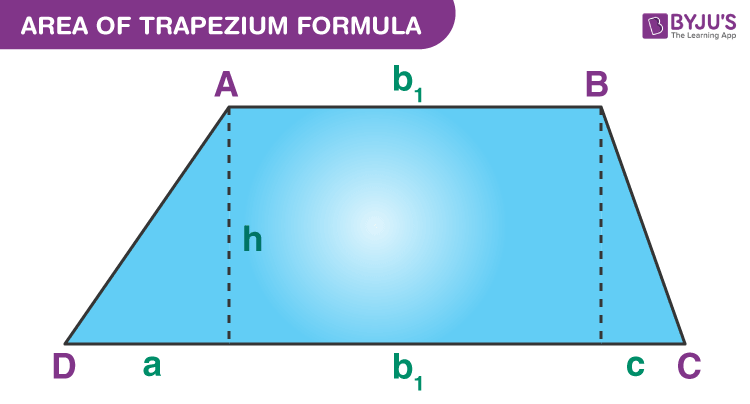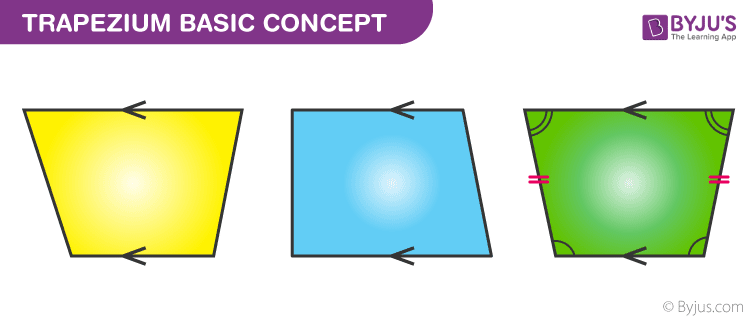Area Of Trapezium
Area of trapezium is the region covered by a trapezium in a two-dimensional plane. It is the space enclosed in 2D geometry and measured in square units. A trapezium is a 2D shape that falls under the category of quadrilaterals. Similar to other geometrical shapes, it also has its own properties and formulas based on area and perimeter. Hence, the area of the trapezium formula is explained in the article along with its derivation and examples to make you understand better.
What is Area of Trapezium?
A trapezium is a quadrilateral, which is defined as a shape with four sides and one set of parallel sides. Thus, the area of trapezium is the region covered within these four sides. The area of the trapezium basically depends upon the length of parallel sides and height of the trapezium. It is measured in square units. Let us see the formula to find the area of any trapezium.
Area of a Trapezium Formula
Trapezium area can be calculated by using the below formula:
| Area = (1/2) h (a+b) |
where,
- a and b are the length of parallel sides/bases of the trapezium
- h is the height or distance between parallel sides.

From the figure, area of trapezium = 1/2 (AB + DC).h
Perimeter of Trapezium
The perimeter of trapezium formula is given by:
| Perimeter = Sum of all the sides = AB + BC + CD + DA |
Derivation of Area of a Trapezium
Following is the derivation for computing the area of the trapezium:
The area of a trapezoid is equal to the sum of the areas of the two triangles and the area of the rectangle.
We know that
area of trapezoid = area of triangle 1 + area of rectangle + area of triangle 2.
That means,
A = (ah/2) + b1h + (ch/2)
A = (ah + 2b1h + ch)/2
Simplifying the equation, rearranging the terms, and factoring result to:
A = h/2[b1 + (a + b1 + c)] ….(i)
If we assume the longer base of the trapezoid be b2, then
b2 = a + b1 + c …..(ii)
Substituting (ii) in equation (i),
A = h/2(b1 + b2)
Therefore, the area of a trapezoid with bases b1, b2 and altitude h is;
A = h/2(b1+b2)
How to Calculate Area of Trapezium?
To find the area of a trapezium, follow the below-given steps:
- Step 1: Find the dimensions of given trapezium, i.e., length of parallel sides and length of height.
- Step 2: Add the length of parallel sides
- Step 3: Multiply the sum of parallel sides with the height of trapezium
- Step 4: Now, multiply the above-calculated value by 1/2 to get the final answer
The obtained value in step 4 is the area of the given trapezium.
Video Lesson on Area of Trapezium

Trapezium Basic Concept
- The pair of parallel sides are called the bases while the non-parallel sides are called the legs of the trapezoid
- The line segment connecting the midpoints of the non-parallel sides of a trapezoid is called the mid-segment

- Check above the different types of trapezium figures, where the arrow represents the parallel side of it. In all the three figures you can see, the two sides are parallel to each other, whereas the other two sides are non-parallel
- If we draw a line segment, between the two non-parallel sides, from the mid-point of both sides, the trapezium will be divided into two unequal parts.
- You must have learned of isosceles triangles, where the two sides of a triangle are equal and the angle opposite the equal sides are also equal. In the same way, we have a figure, which is stated as Isosceles Trapezium, where the two non-parallel sides are equal and form equal angles at one of the bases. You can see the example of it, in the third figure given above.
Properties of a Trapezium
Here, we are going to learn about some more properties of the trapezium, which is also called a trapezoid. A trapezium has the following properties:
- Like other quadrilaterals, the sum of all the four angles of the trapezium is equal to 360°
- A trapezium has two parallel sides and two non-parallel sides
- The diagonals of regular trapezium bisect each other
- The length of the mid-segment is equal to half the sum of the parallel bases, in a trapezium
- Two pairs of adjacent angles of a trapezium formed between the parallel sides and one of the non-parallel side, add up to 180 degrees
Applications of Trapezium
The concept is a highly used concept in various physics computations and other mathematical calculations. This is the basis for obtaining the equations of motion as described in the 9th CBSE science textbook. The blend of the physics equations and mathematical calculations is very well explained to clear the level of understanding of a budding engineering mind.
Related Articles
Solved Examples on Area of Trapezium
Q.1: Find the area of a trapezium whose length of parallel sides are 4cm and 6cm respectively and height is 3 cm.
Solution: Given,
length of parallel sides of trapezium;
a = 4cm
b = 6cm
Height of trapezium, h = 3cm
Therefore,
area of trapezium = 1/2 (a+b).h
= 1/2 (4 + 6) x 3
= 15 sq cm.
Q.2: What is the area of a trapezium when bases are 12 cm and 20 cm respectively and the distance between the two parallel sides is 10 cm?
Solution: Given,
a = 12 cm
b = 20 cm
distance between two parallel side, h = 10 cm
Area of trapezium = 1/2 (12 + 20) 10
= 160 sq.cm
For the complete understanding and concept clearance, one must go through the practice worksheets at BYJU’S to check their hands on the concept and test learning.
Frequently Asked Questions on Area of Trapezium
What is the formula for Area of a trapezium?
The formula to calculate the area of trapezium is:
Area = ½ x Sum of parallel sides x Distance between the parallel sides
What are the formulas for Area and Perimeter of Trapezium?
Area of trapezium = ½ x (a+b) x h
Perimeter of trapezium = a+b+c+d
Where a, b, c and d are the length of sides of a trapezium
And h is the distance between the two parallel sides i.e., a and b.
What are the properties of Trapezium?
A trapezium has 4 unequal sides: two parallel and two non-parallel sides
Sum of all interior angles is 360 degrees
Diagonals bisect each other
How do you find the area of Trapezium?
The area of trapezium depends on its parallel sides and distance between the parallel sides.
If we know the length of parallel sides and the distance between them, then we can easily find the area of trapezium.